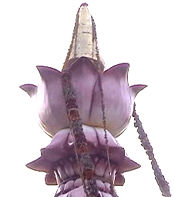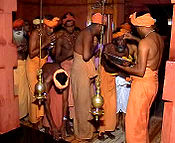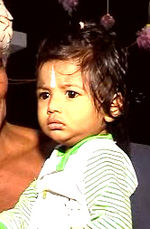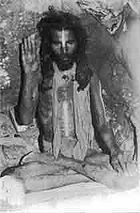
Thirunamam
Encyclopedia
Thirunamam Thiru + Namam (name), --> The Sacred name. It represents the 'Sacred name of God'. The phrase Namam also represents the coarse white soil found at the deeper layer of earth, which is used as the powder to wear a flame shaped mark. The Ayyavazhi
people wore this Namam, starting from the central point between the eyebrows, going straight up near the top edge of the forehead.
The flame shape represents Aanma Jyothi or Atman
. Which in turn means that, Aatman is considered sacred and as the name of God
. Zealous devotees smeared it on the exterior of the upper arms, over the chest and below the spinal cord area at the back.
This white mark was unlike the one worn by a Hindu of Vaishnavism
tradition who wore it on the forehead in the shape of 'U', or of Saivism tradition who wore it horizontally as three parallel lines. This Thirunamam is also called as Tottu Namam and Thiruman.
 In the nineteenth century Travancore
In the nineteenth century Travancore
society, the social setup is highly marked for the discriminative hierarchical caste
order and the inhumanties unfold from this, such as untouchability
, unseeability and unapproachability accordingly some people were shunned from the public approach and sight. This caste based social reality is transformed into a religious institution. The then political faculties duly safegaurded this order. Even in temple the priests while handing over the Prasatam (a ritual object) to devotees after worship, they approach freely with the higher caste
s, whose nearness and touch would not pollute them, and use to throw the Prasatam on to a platform from where the lower caste devotee (whose touch may pollute him) has to collect this.
In such a social conscience, the alternative form of ritual marking 'Tottu Namam' generated. The very name 'Tottu Namam' says the meaning, 'a mark with a personal touch'. In Ayyavazhi
universe primarily, Ayya Vaikundar
seems to have personally touched the forehead of followers and worn it for them.
 This dimension of personal touch stood out to the public eye and was much appreciated by the then society. It presented itself to be a symbolic site wherein new and alternative modes of social relations were proposed, forged and legiminated. It recast the priest-devotee relationship to bear upon the social reality of the time.
This dimension of personal touch stood out to the public eye and was much appreciated by the then society. It presented itself to be a symbolic site wherein new and alternative modes of social relations were proposed, forged and legiminated. It recast the priest-devotee relationship to bear upon the social reality of the time.
The alternative relationship and close contact brought up by this ritual practice meant a reversal of the hierarchical social relationship and discrimination based on purity
and pollution
. In other words, with the under-lying ritual ambience, this 'Tottu Namam' acted fast against the caste based and other inequalities prevalent in the then Travancore
Kingdom and Tamil society
.
Under sociology, the then 'social discriminative force' is termed as the evil spirit of Kali
. And this Kali is said to be get destroyed by the ritual practise of wearing 'Thiru Namam'. The break-point of social hierarchy is channeled in a religious way.
 Unlike the social definition for this ritual practice, the religious or ritual importance for Thirunamam fits to all period of time. Sociologically, while this practice is a basic need, to reform a society (19th century Travancore
Unlike the social definition for this ritual practice, the religious or ritual importance for Thirunamam fits to all period of time. Sociologically, while this practice is a basic need, to reform a society (19th century Travancore
), religiously the same is performed just with a religious belief. The religious definition for the practice 'Tottu Namam' is as The Name of God. The Atman
is assumed to be in a flame shape and it as the name of God
. That is, the Atman
is God and the supreme self.
It was religiously taught that, one who pay extreme belief over Vaikundar will be turned of to the name of God (Atman). And hence the 'purified jeeva
' is an Absolute Atman or God. Also the Thirunamam is smeared between the 'central point of the eyebrows' where the Ajna
Chakra is situated. This chakra
is viewed in relation to the Kali Yuga
of the 'Eight yuga circle' as per Ayyavazhi
scriptures. Since the present yuga is the Kali, the 'Thiru Namam' or the name of God is to be smeared there in Ajna (place of Kali
) for purifying the Jeevas from Kali in order to attain the sacred feet of God. i.e.)Wearing the gods name purifies the jeevas and transform them to the absolute self.
 Presently this practise is considered as the primary ritual to be performed in Pathis and Thangals. Those who 'serve' in every Pathi
Presently this practise is considered as the primary ritual to be performed in Pathis and Thangals. Those who 'serve' in every Pathi
s or Nizhal Thangals, wear this white mark for the people and give a portion of it in their hands. People carry it home as holy object, and some of them even swallow a little of it believing it to be medicinal. The 'Thiru mun' (sacred soil) for preparing the Thiru Namam is collected from Swamithope pathi for Nizhal Thangal
s after conducting the Pothippu
. But some Thangals prepare them as their own.
Akilam, the primary scripture too accredit this ritual practice to be ceremonial and sacred. And it was practiced and treated with high religious importance and as the primary ritual from the celebration conducted in Swamithope pathi
even during the period of Vaikundar. The secondary scripture Arul Nool
too refers that, Ayya personally touched the devotees and wore Thirunamam for them.
Since Vaikundar used ordinary soil as 'Thiru Namam' during his Tavam(austrity) period, ordinary soil is kept there now in alternative of the white soil in the Vatakku Vasal
, where Ayya
performed the Tavam
.
since 1940s and then the present symbol Lotus and Namam was accepted as the symbol. Even in the present symbol the Thirunamam is used with the same religious definition as the Atman
.
 In Ayyavazhi symbolism this Atman is placed above Sahasrara
In Ayyavazhi symbolism this Atman is placed above Sahasrara
which is symbolised as Namam above Lotus. It shows that, the Atman
reaches the state of supreme self or becomes unified with the supreme Ekam
, when it reaches Sahasrara
after moving towards the seven other chakras.
Some Nizhal Thangal
s use this symbol Thirunamam as building architecture. Mostly all Thangals use to mount the symbol at the top either with a lotus
or not.
Ayyavazhi
Ayyavazhi is a dharmic belief system that originated in South India in the 19th century. It is cited as an independent monistic religion by several newspapers, government reports and academic researchers. In Indian censuses, however, the majority of its followers declare themselves as Hindus...
people wore this Namam, starting from the central point between the eyebrows, going straight up near the top edge of the forehead.
The flame shape represents Aanma Jyothi or Atman
Atman (Hinduism)
Ātman is a Sanskrit word that means 'self'. In Hindu philosophy, especially in the Vedanta school of Hinduism it refers to one's true self beyond identification with phenomena...
. Which in turn means that, Aatman is considered sacred and as the name of God
God
God is the English name given to a singular being in theistic and deistic religions who is either the sole deity in monotheism, or a single deity in polytheism....
. Zealous devotees smeared it on the exterior of the upper arms, over the chest and below the spinal cord area at the back.
This white mark was unlike the one worn by a Hindu of Vaishnavism
Vaishnavism
Vaishnavism is a tradition of Hinduism, distinguished from other schools by its worship of Vishnu, or his associated Avatars such as Rama and Krishna, as the original and supreme God....
tradition who wore it on the forehead in the shape of 'U', or of Saivism tradition who wore it horizontally as three parallel lines. This Thirunamam is also called as Tottu Namam and Thiruman.
Social synonym

Travancore
Kingdom of Travancore was a former Hindu feudal kingdom and Indian Princely State with its capital at Padmanabhapuram or Trivandrum ruled by the Travancore Royal Family. The Kingdom of Travancore comprised most of modern day southern Kerala, Kanyakumari district, and the southernmost parts of...
society, the social setup is highly marked for the discriminative hierarchical caste
Caste
Caste is an elaborate and complex social system that combines elements of endogamy, occupation, culture, social class, tribal affiliation and political power. It should not be confused with race or social class, e.g. members of different castes in one society may belong to the same race, as in India...
order and the inhumanties unfold from this, such as untouchability
Untouchability
Untouchability is the social practice of ostracizing a minority group by segregating them from the mainstream by social custom or legal mandate. The excluded group could be one that did not accept the norms of the excluding group and historically included foreigners, nomadic tribes, law-breakers...
, unseeability and unapproachability accordingly some people were shunned from the public approach and sight. This caste based social reality is transformed into a religious institution. The then political faculties duly safegaurded this order. Even in temple the priests while handing over the Prasatam (a ritual object) to devotees after worship, they approach freely with the higher caste
Caste
Caste is an elaborate and complex social system that combines elements of endogamy, occupation, culture, social class, tribal affiliation and political power. It should not be confused with race or social class, e.g. members of different castes in one society may belong to the same race, as in India...
s, whose nearness and touch would not pollute them, and use to throw the Prasatam on to a platform from where the lower caste devotee (whose touch may pollute him) has to collect this.
In such a social conscience, the alternative form of ritual marking 'Tottu Namam' generated. The very name 'Tottu Namam' says the meaning, 'a mark with a personal touch'. In Ayyavazhi
Ayyavazhi
Ayyavazhi is a dharmic belief system that originated in South India in the 19th century. It is cited as an independent monistic religion by several newspapers, government reports and academic researchers. In Indian censuses, however, the majority of its followers declare themselves as Hindus...
universe primarily, Ayya Vaikundar
Ayya Vaikundar
Ayya Vaikundar , according to Akilattirattu Ammanai , a scripture of the Ayyavazhi, was a Manu Avatar of Narayana, incarnated as Muthukutty or Mudisoodum Perumal, a Nadar of Swamithoppe, Tamil Nadu Ayya Vaikundar , according to Akilattirattu Ammanai (or Akilam), a scripture of the Ayyavazhi, was...
seems to have personally touched the forehead of followers and worn it for them.

The alternative relationship and close contact brought up by this ritual practice meant a reversal of the hierarchical social relationship and discrimination based on purity
Virtue
Virtue is moral excellence. A virtue is a positive trait or quality subjectively deemed to be morally excellent and thus is valued as a foundation of principle and good moral being....
and pollution
Pollution
Pollution is the introduction of contaminants into a natural environment that causes instability, disorder, harm or discomfort to the ecosystem i.e. physical systems or living organisms. Pollution can take the form of chemical substances or energy, such as noise, heat or light...
. In other words, with the under-lying ritual ambience, this 'Tottu Namam' acted fast against the caste based and other inequalities prevalent in the then Travancore
Travancore
Kingdom of Travancore was a former Hindu feudal kingdom and Indian Princely State with its capital at Padmanabhapuram or Trivandrum ruled by the Travancore Royal Family. The Kingdom of Travancore comprised most of modern day southern Kerala, Kanyakumari district, and the southernmost parts of...
Kingdom and Tamil society
Tamil people
Tamil people , also called Tamils or Tamilians, are an ethnic group native to Tamil Nadu, India and the north-eastern region of Sri Lanka. Historic and post 15th century emigrant communities are also found across the world, notably Malaysia, Singapore, Mauritius, South Africa, Australia, Canada,...
.
Under sociology, the then 'social discriminative force' is termed as the evil spirit of Kali
Kaliyan
Kali was the sixth fragment of the primordial manifestation of Kroni according to Akilam, the source of Ayyavazhi mythology and the holy book of Ayyavazhi religion. Unlike other previous manifestations, Kali spread in this yugam as maya...
. And this Kali is said to be get destroyed by the ritual practise of wearing 'Thiru Namam'. The break-point of social hierarchy is channeled in a religious way.
Religious understanding

Travancore
Kingdom of Travancore was a former Hindu feudal kingdom and Indian Princely State with its capital at Padmanabhapuram or Trivandrum ruled by the Travancore Royal Family. The Kingdom of Travancore comprised most of modern day southern Kerala, Kanyakumari district, and the southernmost parts of...
), religiously the same is performed just with a religious belief. The religious definition for the practice 'Tottu Namam' is as The Name of God. The Atman
Atman (Hinduism)
Ātman is a Sanskrit word that means 'self'. In Hindu philosophy, especially in the Vedanta school of Hinduism it refers to one's true self beyond identification with phenomena...
is assumed to be in a flame shape and it as the name of God
God
God is the English name given to a singular being in theistic and deistic religions who is either the sole deity in monotheism, or a single deity in polytheism....
. That is, the Atman
Atman (Hinduism)
Ātman is a Sanskrit word that means 'self'. In Hindu philosophy, especially in the Vedanta school of Hinduism it refers to one's true self beyond identification with phenomena...
is God and the supreme self.
It was religiously taught that, one who pay extreme belief over Vaikundar will be turned of to the name of God (Atman). And hence the 'purified jeeva
Jeeva
Jeeva may refer to:* Jeeva, P. Jeevanandham , Indian politician* Jeeva , Tamil Movie Director* Jeeva , Indian* Jeeva , Indian Tamil actor* Jeeva, Lollu Sabha actor...
' is an Absolute Atman or God. Also the Thirunamam is smeared between the 'central point of the eyebrows' where the Ajna
Ajna
Ajna is the sixth primary chakra according to Hindu tradition.-Location:The Ajna chakra is positioned in the brain, directly behind the eyebrow centre, while its ksehtram or superficial activation site is at the eyebrow region, in the position of the 'third eye'.-Appearance:Ajna is white in...
Chakra is situated. This chakra
Chakra
Chakra is a concept originating in Hindu texts, featured in tantric and yogic traditions of Hinduism and Buddhism. Its name derives from the Sanskrit word for "wheel" or "turning" .Chakra is a concept referring to wheel-like vortices...
is viewed in relation to the Kali Yuga
Kali Yuga
Kali Yuga is the last of the four stages that the world goes through as part of the cycle of yugas described in the Indian scriptures. The other ages are Satya Yuga, Treta Yuga and Dvapara Yuga...
of the 'Eight yuga circle' as per Ayyavazhi
Ayyavazhi
Ayyavazhi is a dharmic belief system that originated in South India in the 19th century. It is cited as an independent monistic religion by several newspapers, government reports and academic researchers. In Indian censuses, however, the majority of its followers declare themselves as Hindus...
scriptures. Since the present yuga is the Kali, the 'Thiru Namam' or the name of God is to be smeared there in Ajna (place of Kali
Kaliyan
Kali was the sixth fragment of the primordial manifestation of Kroni according to Akilam, the source of Ayyavazhi mythology and the holy book of Ayyavazhi religion. Unlike other previous manifestations, Kali spread in this yugam as maya...
) for purifying the Jeevas from Kali in order to attain the sacred feet of God. i.e.)Wearing the gods name purifies the jeevas and transform them to the absolute self.
As a ritual

Pathi
Pathi is the name of the primary centres of congregational worship for the South Indian religious system of Ayyavazhi, having a relatively large structure like that of a temple...
s or Nizhal Thangals, wear this white mark for the people and give a portion of it in their hands. People carry it home as holy object, and some of them even swallow a little of it believing it to be medicinal. The 'Thiru mun' (sacred soil) for preparing the Thiru Namam is collected from Swamithope pathi for Nizhal Thangal
Nizhal Thangal
Nizhal Thangal are secondary worship places of the Ayyavazhi, often smaller in size compared to Pathis, built per the instructions of Akilattirattu Ammanai...
s after conducting the Pothippu
Pothippu
The Pothippu is one of the sub-sections of Arul Nool which was the secondary scripture of Ayyavazhi.The author of the content is unknown. This is a prayer form called 'Mappu Kettal'....
. But some Thangals prepare them as their own.
Akilam, the primary scripture too accredit this ritual practice to be ceremonial and sacred. And it was practiced and treated with high religious importance and as the primary ritual from the celebration conducted in Swamithope pathi
Swamithope Pathi
Swamithoppe Pathi , Swamithoppu-pathi, Manavai-pathi, Thamarai-pathi or Thalaimaippathi [Thalaimai + pathi] is the primary pathi of the Ayyavazhi, the head of all Worship centers of Ayyavazhi, and the place where Ayya Vaikundar is said to have performed the Tavam...
even during the period of Vaikundar. The secondary scripture Arul Nool
Arul Nool
The Arul Nool is a supplement to the Akilattirattu Ammanai, and is likewise considered a holy scripture of Ayyavazhi, an offshoot sect of Hinduism. This book contains the collection of messages given by Ayya Vaikundar to his Disciples , whose names are unknown...
too refers that, Ayya personally touched the devotees and wore Thirunamam for them.
Since Vaikundar used ordinary soil as 'Thiru Namam' during his Tavam(austrity) period, ordinary soil is kept there now in alternative of the white soil in the Vatakku Vasal
Vatakku Vasal
Vatakku Vasal is the north entrance of Swamithoppe pathi. It was here Ayya Vaikundar performed his Tavam. This is considered sacred by the followers of Ayyavazhi. During the Eleven-day festival in Swamithoppe, on the eight day after the Kali vettai, scene of austirity of Ayya Vaikundar was...
, where Ayya
Ayya
Ayya is a Pali word, translated as "honourable" or "worthy."It is most commonly used as a veneration in addressing or referring to an ordained female Buddhist monk, most often of the Theravadan tradition in southeast Asia...
performed the Tavam
Tavam of Vaikundar
According to Akilattirattu Ammanai, For ten months, Ayya Vaikundar revealed to the people all about the past, present, and future in the form of songs. He sang definitively about the future. Some of those who heard him, took his words as meaningless mutterings...
.
In Ayyavazhi symbolism
This Thirunaman, a white flame-shaped mark, is treated as the symbol of AyyavazhiAyyavazhi
Ayyavazhi is a dharmic belief system that originated in South India in the 19th century. It is cited as an independent monistic religion by several newspapers, government reports and academic researchers. In Indian censuses, however, the majority of its followers declare themselves as Hindus...
since 1940s and then the present symbol Lotus and Namam was accepted as the symbol. Even in the present symbol the Thirunamam is used with the same religious definition as the Atman
Atman (Hinduism)
Ātman is a Sanskrit word that means 'self'. In Hindu philosophy, especially in the Vedanta school of Hinduism it refers to one's true self beyond identification with phenomena...
.

Sahasrara
Sahasrara/ Sahastrara is the seventh primary chakra according to Hindu tradition.-Location:Sahasrara is either located at the top of the head in that one area, or a little way above it .-Appearance:Sahasrara is described with 1,000 multi-coloured petals which are arranged in 20 layers each of them...
which is symbolised as Namam above Lotus. It shows that, the Atman
Atman (Hinduism)
Ātman is a Sanskrit word that means 'self'. In Hindu philosophy, especially in the Vedanta school of Hinduism it refers to one's true self beyond identification with phenomena...
reaches the state of supreme self or becomes unified with the supreme Ekam
Ekam
Ekam Tamil: - "the supreme oneness") is the term used in Akilathirattu Ammanai, the holy book of Ayyavazhi, to represent The Ultimate Oneness. In Thiruvasakam-2 it was stated that it was from this Ekam that all objects, including the separate Godheads, Devas and asuras, of the universe formed...
, when it reaches Sahasrara
Sahasrara
Sahasrara/ Sahastrara is the seventh primary chakra according to Hindu tradition.-Location:Sahasrara is either located at the top of the head in that one area, or a little way above it .-Appearance:Sahasrara is described with 1,000 multi-coloured petals which are arranged in 20 layers each of them...
after moving towards the seven other chakras.
Some Nizhal Thangal
Nizhal Thangal
Nizhal Thangal are secondary worship places of the Ayyavazhi, often smaller in size compared to Pathis, built per the instructions of Akilattirattu Ammanai...
s use this symbol Thirunamam as building architecture. Mostly all Thangals use to mount the symbol at the top either with a lotus
Lotus (plant)
Lotus identifies various plant taxa:* Nelumbo, a genus of aquatic plants with showy flowers** Nelumbo nucifera, the Sacred or Indian lotus** Nelumbo lutea, the American or Yellow lotus...
or not.
External links
- www.vaikunt.org - Applying sacred clay by touching (Thottu Namam)
- www.ayyavazhi.org - Social Reforms
See also
- List of Ayyavazhi-related articles
- Ayyavazhi rituals
- Ayya VaikundarAyya VaikundarAyya Vaikundar , according to Akilattirattu Ammanai , a scripture of the Ayyavazhi, was a Manu Avatar of Narayana, incarnated as Muthukutty or Mudisoodum Perumal, a Nadar of Swamithoppe, Tamil Nadu Ayya Vaikundar , according to Akilattirattu Ammanai (or Akilam), a scripture of the Ayyavazhi, was...
- Muthirikkinaru

